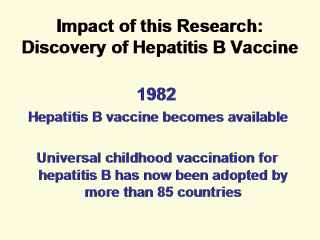 |
The hepatitis
B vaccine has been available since 1982. The vaccines currently in use in
the United States are made with recombinant DNA technology, and contain
protein portions of HBV (usually parts of the outer protein or the surface
antigen of HBV). Thus, the vaccines do not contain any live virus. The
vaccine is administered intramuscularly in three doses usually given on a
schedule of 0,1, and 6 months, but there can be flexibility in this
schedule. More than 95% of children and adolescents and more than 90% of
young, healthy adults develop adequate immunity following the recommended
three doses. Persons who respond to the vaccine are protected from both
acute hepatitis B infections as well as chronic infection.
Because infants or children infected with hepatitis B
virus have an extremely high risk of becoming lifelong carriers of the
disease, universal childhood vaccination for hepatitis B has now been
adopted by more than 85 countries, including the United States. |
